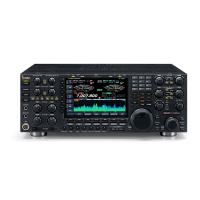7-10
■ Programming a memory name
Memory channels can be tagged with alphanumeric
names of up to 20 characters each.
You can use capital letters, small letters, numerals,
somesymbols(!#$%&¥?“‘`^+–✱ / . , : ; = < > (
) [ ] { } | _
~
@) and spaces. (See the table below.)
[F-1•Ω] [F-2•≈] [F-4•SPACE] [F-7•T1..T4]
[F-3•DEL] Keypad[ABC]/[abc] [123]/[Symbol]
q Record a message as described in page 7-9.
w During the voice mic. record screen indication, push
[F-5•NAME]toentermemorynameeditcondition.
•Acursorappearsandblinks.
ePush[F-7•T1..T4]severaltimestoselectthede-
sired voice memory.
r Input the desired character by rotating the main dial
or by pushing the band key for number input.
•Push[ABC]or[abc]totogglecapitalandsmallletters.
•Push [123]or[Symbol]totogglenumeralsand sym-
bols.
•Push[F-1•Ω]or[F-2•≈] for cursor movement.
•Push[F-3•DEL]todeletetheselectedcharacter.
•Push[F-4•SPACE]toinputaspace.
•Pushingthetransceiver’skeypad,[0]–[9],canalsoenter
numerals.
t Push [EXIT/SET] to input and set the name.
•Thecursordisappears.
y Repeat steps e to t to program another voice
memory’s name, if desired.
uPush[EXIT/SET]twicetoexittheVoiceRecorder
screen.
• Voice memory name editing example • Usable characters
7
VOICE RECORDER FUNCTIONS
Key selection Editable characters
A to Z (capital letters)
a to z (small letters)
0 to 9 (numbers)
!#$%&¥?“‘`^+–✱ / . , : ; =
< > ( ) [ ] { } | _
~
@

